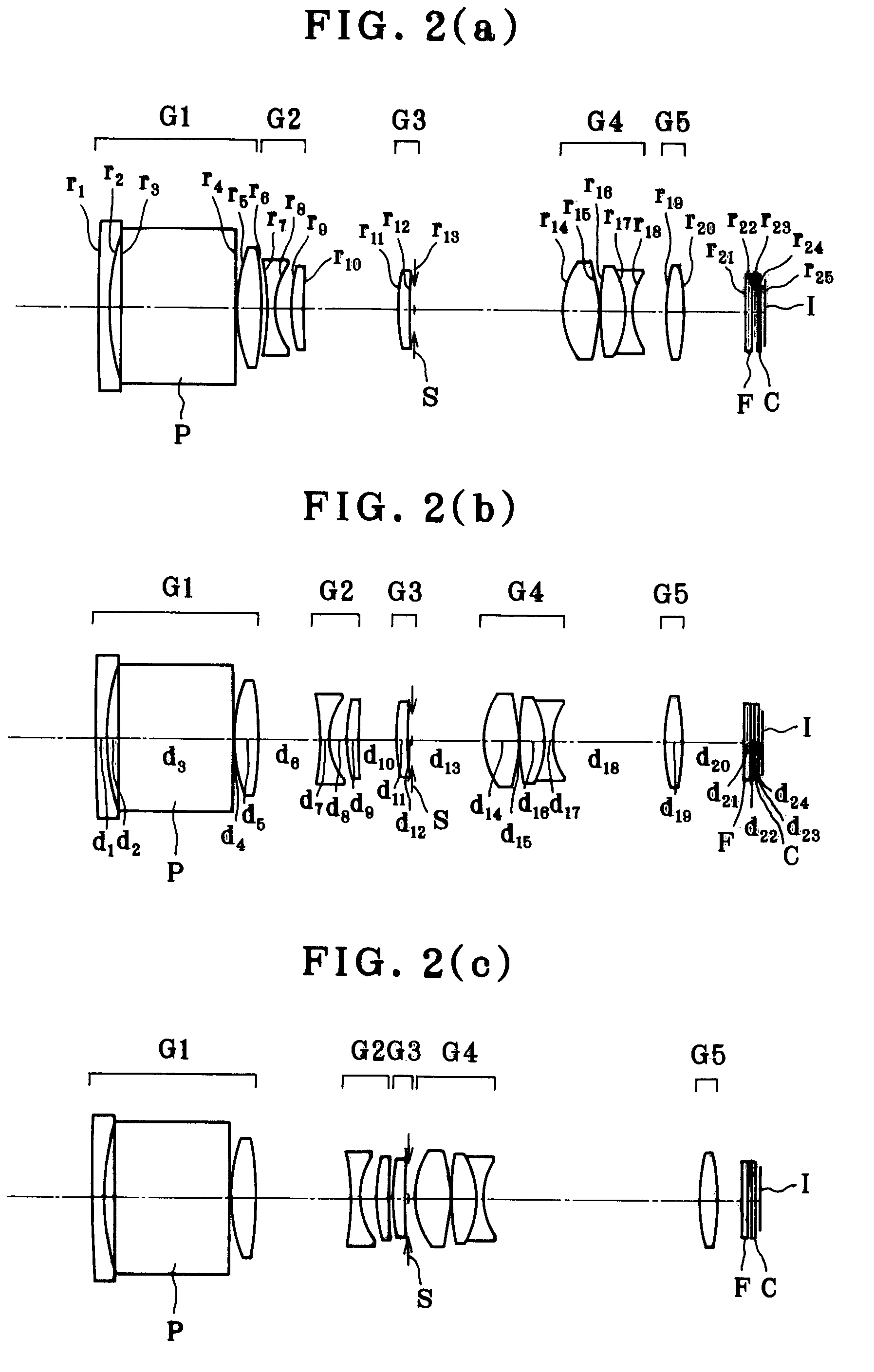Bent type zoom optical system, and imager, information processor and electronic camera apparatus incorporating the same
a zoom optical system and optical system technology, applied in the field ofbent-type zoom optical system, can solve the problems of still less than satisfactory in terms of size reduction, hard to achieve size reduction, etc., and achieve the effect of reducing the movement of simplifying the second lens group, and easing the load
- Summary
- Abstract
- Description
- Claims
- Application Information
AI Technical Summary
Benefits of technology
Problems solved by technology
Method used
Image
Examples
example 1
[0126]
r1 = −130.174d1 = 1.20nd1 = 1.92286νd1 = 20.88r2 = 43.086d2 = 0.94r3 = ∞d3 = 13.80nd2 = 1.80100νd2 = 34.97r4 = ∞d4 = 0.20r5 = 16.322d5 = 2.56nd3 = 1.76802νd3 = 49.24r6 = −47.877d6 = (Variable)(Aspheric)r7 = −35.713d7 = 1.00nd4 = 1.80610νd4 = 40.92r8 = 5.604d8 = 2.17(Aspheric)r9 = 14.804d9 = 1.56nd5 = 1.92286νd5 = 20.88r10 = 41.407d10 = (Variable)r11 = 18.499d11 = 1.39nd6 = 1.92286νd6 = 20.88r12 = 29.001d12 = 0.80r13 = ∞(Stop)d13 = (Variable)r14 = 8.547 (Aspheric)d14 = 4.15nd7 = 1.49700νd7 = 81.54r15 = −13.837d15 = 0.20(Aspheric)r16 = 48.789d16 = 3.81nd8 = 1.61800νd8 = 63.33r17 = −7.488d17 = 0.65nd9 = 1.64769νd9 = 33.79r18 = 7.488d18 = (Variable)r19 = 19.943d19 = 2.32nd10 = 1.52542νd10 = 55.78r20 = −25.502d20 = (Variable)(Aspheric)r21 = ∞d21 = 0.75nd11 = 1.51633νd11 = 64.14r22 = ∞d22 = 0.50r23 = ∞d23 = 0.50nd12 = 1.51633νd12 = 64.14r24 = ∞d24 = 0.37r25 = ∞(Imaging plane)Aspherical Coefficients6th surfaceK = 0.000A4 = 5.53951 × 10−5A6 = 7.45682 × 10−8A8 = −9.62928 × 10−9A10 = 1....
example 2
[0127]
r1 = 252.674d1 = 1.20nd1 = 1.92286νd1 = 20.88r2 = 25.849d2 = 1.55r3 = ∞d3 = 13.80nd2 = 1.80100νd2 = 34.97r4 = ∞d4 = 0.20r5 = 18.961d5 = 2.85nd3 = 1.77377νd3 = 47.17r6 = −36.901d6 = (Variable)(Aspheric)r7 = −24.023d7 = 1.00nd4 = 1.80610νd4 = 40.92r8 = 6.787 (Aspheric)d8 = 1.90r9 = 17.424d9 = 1.45nd5 = 1.92286νd5 = 20.88r10 = 48.482d10 = (Variable)r11 = 21.867d11 = 1.43nd6 = 1.92286νd6 = 20.88r12 = 44.453d12 = 0.62r13 = ∞(Stop)d13 = (Variable)r14 = 8.026 (Aspheric)d14 = 4.33nd7 = 1.49700νd7 = 81.54r15 = −17.674d15 = 0.20(Aspheric)r16 = 32.791d16 = 3.06nd8 = 1.61800νd8 = 63.33r17 = −10.025d17 = 0.70nd9 = 1.64769νd9 = 33.79r18 = 6.700d18 = (Variable)r19 = 19.385d19 = 2.24nd10 = 1.49700νd10 = 81.54r20 = −28.616d20 = (Variable)(Aspheric)r21 = ∞d21 = 0.75nd11 = 1.51633νd11 = 64.14r22 = ∞d22 = 0.50r23 = ∞d23 = 0.50nd12 = 1.51633νd12 = 64.14r24 = ∞d24 = 0.37r25 = ∞(Imaging plane)Aspherical Coefficients6th surfaceK = 0.000A4 = 4.34741 × 10−5A6 = 1.17640 × 10−8A8 = −3.40284 × 10−9A10 = 4...
example 3
[0128]
r1 = −149.275d1 = 1.20nd1 = 1.92286νd1 = 20.88r2 = 27.013d2 = 1.56r3 = ∞d3 = 15.40nd2 = 1.80100νd2 = 34.97r4 = ∞d4 = 0.20r5 = 71.283d5 = 1.87nd3 = 1.69680νd3 = 55.53r6 = −106.683d6 = 0.20r7 = 18.326d7 = 3.41nd4 = 1.69350νd4 = 53.21r8 = −63.160d8 = (Variable)(Aspheric)r9 = −36.828d9 = 0.90nd5 = 1.80610νd5 = 40.92r10 = 7.439 (Aspheric)d10 = 1.21r11 = 25.261d11 = 1.29nd6 = 1.84666νd6 = 23.78r12 = 62.543d12 = (Variable)r13 = 21.357d13 = 2.07nd7 = 1.92286νd7 = 20.88r14 = −49.304d14 = 0.50r15 = ∞(Stop)d15 = 1.12r16 = −20.134d16 = 0.62nd8 = 1.80610νd8 = 40.92r17 = 37.635d17 = (Variable)r18 = 10.943d18 = 4.02nd9 = 1.49700νd9 = 81.54(Aspheric)r19 = −15.182d19 = 0.20(Aspheric)r20 = 25.759d20 = 3.39nd10 = 1.69680νd10 = 55.53r21 = −12.450d21 = 0.70nd11 = 1.80100νd11 = 34.97r22 = 17.026d22 = (Variable)r23 = 262.044d23 = 0.65nd12 = 1.80100νd12 = 34.97r24 = 7.700d24 = 4.33nd13 = 1.58913νd13 = 61.28r25 = −15.657d25 = (Variable)(Aspheric)r26 = ∞d26 = 0.75nd14 = 1.51633νd14 = 64.14r27 = ∞d27 = ...
PUM
 Login to View More
Login to View More Abstract
Description
Claims
Application Information
 Login to View More
Login to View More - R&D
- Intellectual Property
- Life Sciences
- Materials
- Tech Scout
- Unparalleled Data Quality
- Higher Quality Content
- 60% Fewer Hallucinations
Browse by: Latest US Patents, China's latest patents, Technical Efficacy Thesaurus, Application Domain, Technology Topic, Popular Technical Reports.
© 2025 PatSnap. All rights reserved.Legal|Privacy policy|Modern Slavery Act Transparency Statement|Sitemap|About US| Contact US: help@patsnap.com



